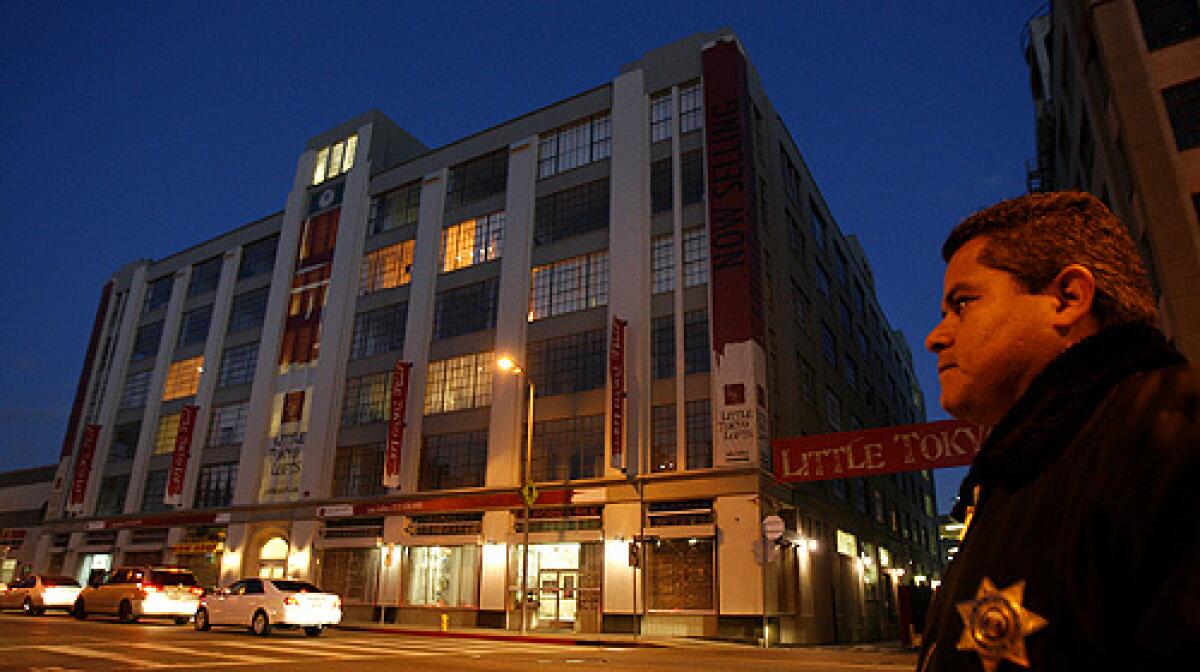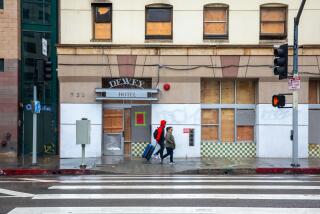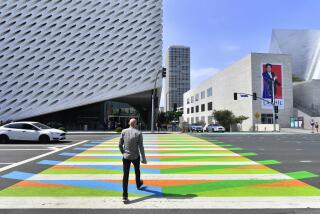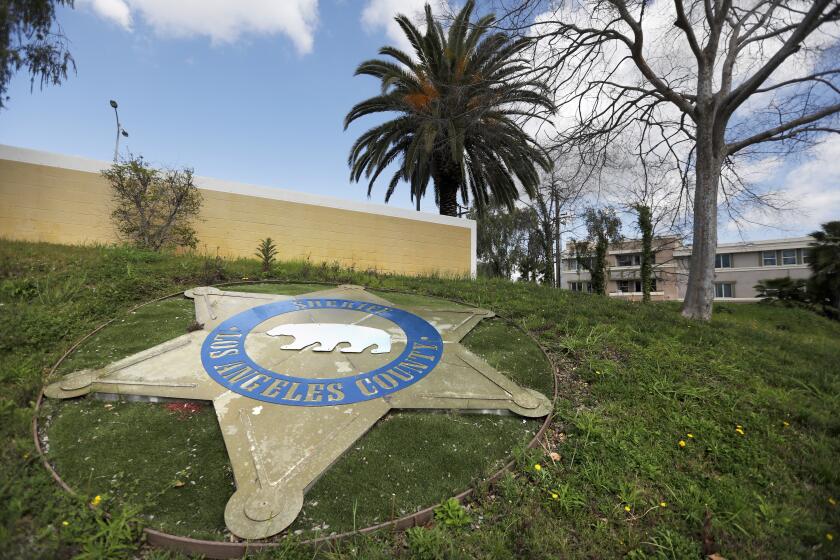Little Tokyo residents resent mental health facilty

When Little Tokyo Lofts opened in downtown a few years ago, they were billed as the antidote to suburban living.
Press materials lured buyers to the former Westinghouse industrial building by promising luxury lofts in an about-to-be-gentrified “vibrant neighborhood” -- which just happened to be at the edge of skid row. And buyers bought the condos, near the corner of 5th and San Pedro streets, hoping that the upscale amenities that had surfaced in other parts of town would follow them there.
So when residents of Little Tokyo Lofts noticed a few months ago that a tenant would be moving into the long-vacant, ground-floor retail space of their building, they got excited and started wondering who it would be. A new restaurant or coffee shop? A dry cleaner?
Then they learned that the space was to be filled by a mental health service provider.
The new neighbor has met with protests from some loft dwellers, who argue that their neighborhood has more than enough social services centers aimed at the homeless population and that what they need is more stores and eateries.
“I know where we live,” said resident Matthew Heller, who was the first person to buy a unit when the building went condo. “I know the homeless people, and some are friends with me. I understand the neighborhood. . . . I’m not saying not in my backyard. I am saying my backyard is already so full.”
The battle over the 6,500-square-foot space in Little Tokyo Lofts underscores one of the biggest issues facing downtown’s transformation into a fully functioning residential neighborhood.
So far, residents have been willing to move into pockets of the city, hoping that amenities such as corner markets, bars, drugstores and other shops would follow. And in some places, that has happened. But in many other parts of downtown, the retail simply isn’t there.
At the long-awaited Ralphs at the southern edge of downtown, the area’s first supermarket in nearly a half century, business has been booming since it opened last year. Other grocery chains, such as Trader Joe’s and Whole Foods, have looked at the area, but have yet to announce a move into the city’s center.
A plan to bring more restaurants and bars to 7th Street is moving forward. And city officials and business owners recently announced a proposal to revamp the old theater district along Broadway -- with new retailers a big part of the plan.
But in many residential locations, “For Lease” signs still hang in the bright open spaces on the ground floor of newly renovated buildings.
For residents of Little Tokyo Lofts, the retail space in their building had held a particular promise. It represented, just as their own units did, another way that gentrification was taking hold in their corner of the city and that the decades-old concentration of social services in the blocks around their building was coming to an end.
“We are absolutely aware of the area where we moved into,” said resident Jack Harding, who moved to the building from Mount Washington 13 months ago. “But that does not mean that we don’t have expectations for its improvement.”
The owner of the retail space says that he moved the nonprofit to the retail space only after months of searching for a retail tenant had yielded nothing. The nonprofit’s director says that the skid row location is not ideal for its clients -- but that the organization couldn’t afford rents in the other neighborhoods they had looked.
“It’s a hard pill for us to swallow,” said Victoria Simon, forensic program director of SSG Central, the mental healthcare provider that moved from a nearby location to Little Tokyo Lofts. “This is not ideal for our clients.”
Little Tokyo Lofts aren’t actually in Little Tokyo; rather, the building is on the cusp of it and several other neighborhoods: skid row, the Toy District and the Arts District.
Inside the six-story building, which was once used for light industrial purposes, units that sell for $400,000 to $1.2 million each boast ceilings that are 12, sometimes 30 feet high, original steel casement windows and designer kitchens outfitted with stainless steel appliances and granite counter tops. The building’s common areas include an open garden courtyard, a pool area and a specially designed dog run.
Outside, the street life reflects the neighborhoods that the building abuts. A green podlike toilet, installed for the use of homeless people who linger nearby, sits at the corner of 5th and San Pedro. A number of homeless service providers are on the block to the south, including the Union Rescue Mission.
In the other direction, wholesale buyers hustle through the Toy District, where crowded stores show off racing cars, silk flowers and women’s underwear.
The area, Harding said, was “very much sold to us as, it may be kind of gritty now, but it is an up-and-coming place.”
“I call it the gateway block,” said resident Erin Schon. “It can either sit there and fall through the cracks or people can take it and use it for something better, an area that becomes a really positive transition between some wonderful areas of downtown.”
When the Downtown Women’s Center made plans to restore a building just south of Little Tokyo Lofts and create 71 units of supportive housing for single, mostly elderly, women, loft residents were supportive of their new neighbors. Loft resident Heller called the new housing “a great environment for people who need it.”
But when residents found out that SSG was moving its mental health services to the ground floor of Little Tokyo Lofts, many of them decided that enough was enough.
Simon said the space will eventually house 20 staff members who would serve as many as 150 clients. Those clients, who will come to the facility for services including case management, therapy, employment assistance and to see a psychiatrist, are all under SSG’s supervision 24/7, Simon said -- and many face steep prison sentences if they do not adhere to the center’s terms for their treatment.
Simon said she understood the loft residents’ frustrations. But she is also fiercely protective of the people her organization serves.
“My only concern was for our clients because I really didn’t want them to feel like the dirty little secret,” she said. “Our clients are working very hard to make significant life changes. They are so marginalized already that I didn’t want to put them in a position where they were coming to do this work and make these changes and feeling as if they weren’t wanted, that we couldn’t say what they were and what they were doing there.”
Steve Lee, landlord of Little Tokyo Lofts’ retail space, wasn’t surprised by the residents’ reaction.
“If I was living upstairs, maybe I wouldn’t like it myself,” he said.
But he noted that the residents “have chosen a very, very challenging place to live.”
Lee said that in the current economic environment, places where there are not a critical mass of housing, such as the area around Little Tokyo Lofts, would suffer because they do not have a built-in infrastructure to support the residents.
“Hopefully, it will get better before it gets worse,” Lee said. “But I don’t think it’s going to be pretty, particularly at this location.”
More to Read
Start your day right
Sign up for Essential California for news, features and recommendations from the L.A. Times and beyond in your inbox six days a week.
You may occasionally receive promotional content from the Los Angeles Times.






